Home
A comprehensive resource for safe and responsible laser use
US: Air Force develops laser glare protection glasses for pilots
Washington State Patrol pilots successfully test special laser eye protection developed at Wright-Patterson Lab
Story by Mary Pacinda, Air Force Research Laboratory
Aiming a laser at an aircraft is a federal crime that can net offenders up to five years in jail or cost them a $250,000 fine. Even with this heavy potential penalty, laser strikes have become increasingly more common. According to the FAA, 6,852 such incidents were reported in 2020, compared with 385 in 2006, and so far this year, incidents of “joy lasing” are up 20 percent over last year. Cheap and easily obtained, hand-held lasers used as pointers and cat toys are certainly harmless when used as intended. But when they are aimed at the cockpit of an aircraft, they can temporarily blind the pilot — with possibly deadly consequences.
Laser strikes are almost always made at low altitudes when an aircraft is taking off or preparing to land — the two parts of flying that require the most attention from a pilot. Even if the beam of light does not hit the pilot’s eyes directly, it can cause a distraction or even raise an alarm that the plane may have become a target. In addition to the possible adverse effects of these human reactions, slight imperfections in the plane’s windscreen can cause the laser light to spread out, creating a glare that can temporarily obscure all vision inside the cockpit.
Of course, passing a law against any behavior — including pointing a laser at an airplane — seldom puts an end to the behavior. Thus, the best way to avoid disaster from laser strikes is to provide some sort of protection for the pilot. As a result, in recent years several manufacturers have developed laser eye protection (LEP) to meet a growing demand for help from military and law enforcement pilots. But this solution is not without problems of its own.
Most laser eye protection works by filtering out green or red light, the colors most commonly used in handheld lasers. Unfortunately, according to FAA studies and years of pilot experience, this can change the pilot’s ability to accurately read the instrument control panel. A 2019 FAA report suggested that this problem might be fixed by changing the type of lighting in the control panel.
Researchers at the Air Force Research Laboratory recently came up with a better solution, one that was successfully tested on the job by Washington State Patrol pilots.
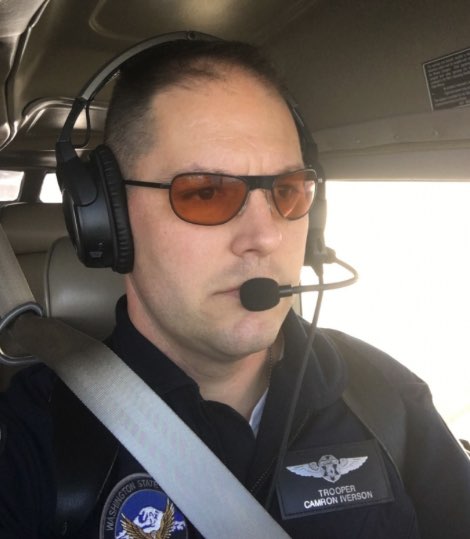
Flight Officer Camron Iverson of the Washington State Patrol tested laser protection lenses formulated at AFRL’s Materials and Manufacturing Directorate. (Photo by Mary Pacinda)
The Personnel Protection Team in AFRL’s Materials and Manufacturing Directorate, headed by Dr. Matthew Lange, used the cockpit compatibility design software developed for Department of Defense LEP and modified it for commercial use. The commercial version, called CALI (Commercial Aviation Low Intensity) filters out the laser light, but not the light coming from the pilot’s instrument panel. “Simply put,” said Lange, “the lenses maximize protection while minimizing the impact to the cockpit.”
Canada: New pilot laser glare protection eyewear using holographic optical filter
The most common laser color reported by pilots is green, representing approximately 90% of reports made to the U.S. Federal Aviation Administration. As of 2019, the most common green is 532 nanometers, produced by low-cost, high-power diode-pumped solid state laser pointers and handhelds.
metaAIR's first offering protects against 532nm green laser light, using holographic "nano-pattern layers". These can precisely reflect 532nm light while allowing high visibility for other wavelengths — crucial for pilots' night vision and for correct color discrimination of cockpit instruments and airport lighting. MTI adds an additional layer to improve color balance and discrimination, as well.
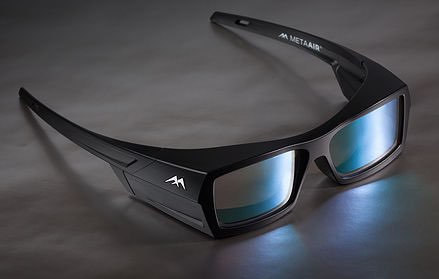
The eyewear is said to have an Optical Density between 2 and 5, meaning that it will attenuate the amount of 532nm light reaching eyes by 100 to 100,000 times. The primary goal is to reduce or eliminate visual interference effects such as flashblindness, glare and distraction. A secondary benefit is that attenuating 532nm light will also help protect against any potential eye injury. (Note that as of February 2019, no documented pilot eye injuries have occurred according to the U.S. FAA, U.K. CAA and Transport Canada after almost 75,000 reports of aircraft illumination. Laser/aviation safety experts consider visual interference to be a more significant safety concern than pilot eye injuries.)
The frame is wider at top, sides and bottom, to block light coming from directions other than the front.
MTI originally developed the holographic laser-reflecting technology for use in windscreens. The goal was to protect pilots without the need for eyewear. However, windscreen modifications require a slow, multi-year process of obtaining governmental and airline approval. In addition, the cost to modify windscreens is much higher than the cost of one or two pairs of eyewear. So eyewear was a natural choice for the first commercially available laser protection product from MTI. According to its metaAIR website, the company may also produce glare shields using the same technology.
MTI is taking pre-orders for its eyewear, distributed by Satair, which will be available "spring 2019."
From MTI's metaAIR website, accessed February 25 2019.
UK: BAE Systems can filter 3 laser wavelengths with 70% normal transmission
According to an October 31 2018 story about BAE's anti-laser efforts, "Bray says a lot of work has gone in to developing products that protect pilots from this form of attack; now much of the challenge is about developing the frames to house the filters."
The story also discussed the number of reported laser incidents in the U.S. and U.K. in recent years, concerns about laser use against military aircraft in the East China Sea and East Africa, and Chinese development of dazzling and blinding laser weapons.
It concludes with Bray's discussion of challenges for laser eye protection: "Among them are achieving performance for off axis incidence of laser, a high absorption at the wavelength of interest whilst keeping the transmission high elsewhere, and ensuing they work, something not easily done given the risk to individuals if they don’t work.”
From Air Force Technology
Canada: Satair, Metamaterials sign anti-laser glare protection distribution deal
Customers will include commercial and military pilots, both fixed-wing and rotary, in markets including commercial aviation, business aviation, search and rescue, police, medevac and military.
Satair is a part of the Airbus Customer Services unit. In 2014 Airbus brought Nova Scotia-based MTI into an innovation start-up program, working to commercialize aircraft windscreen film to protect pilots from laser glare and flashblindness. In June 2017 Satair and MTI signed a memorandum of understanding focused on the civil aviation market.
According to MTI, "Detailed market research and discussions with potential customers since then has confirmed that the overwhelming preference is for this innovative new product to be introduced to the market through individual eyewear and visor products which incorporate MTI’s laser glare protection technology."
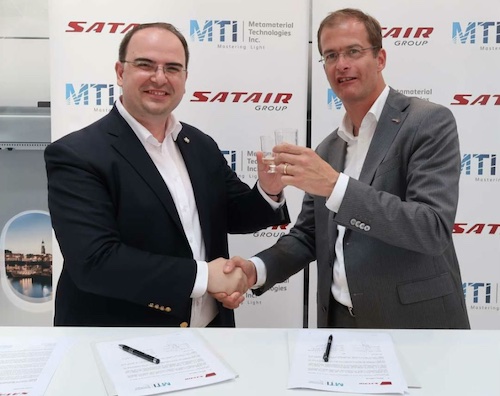
MTI's George Palikaras, founder and CEO (l), and Satair CEO Bart Reijnen (r) sign a distribution agreement at the October 2018 MRO Europe trade show for maintenance, repair and overhaul operations.
The October 2018 agreement widens the market and covers "eyewear and visor products that are developed or manufactured by MTI. These include, without limitation, all sub-components, sub-assemblies, piece parts, software and hardware."
MTI says their technology "is superior to other products currently on the market due to a unique and patented dielectric (non-metallic) optical metamaterial filter, which has been scientifically engineered to ensure that the pilots’ vision and interpretation of the surrounding environment is not disturbed during critical phases of flight."
From an October 17 2018 Metamaterial Technologies Inc. press release
UPDATED: In a February 19 2019 press release, Satair's customer solutions director says initial product applications will appear in the first quarter of 2019. He also said "The technology is highly scalable so it can be customised for a wide variety of platforms and other applications. In commercial aviation the green laser poses the biggest threat because the human eye is more susceptible to the green wavelength. For military markets the red laser may be the largest threat. The advantage of the MTI product compared to other products in the market is that it can be customised to the wavelengths the customer wants to be protected against. As we have exclusive distribution rights across civil aviation, military and defence, we are open to do business with leading OEMs of products such as night vision goggles, head-up displays, helicopter and fighter pilot helmets and aircraft flight deck visors. Other products in the market do not have the same quality, the same level of protection and colour balance that we have.
Thanks to Peter Smith and Leon McLin for bringing the February 2019 press release to our attention.
US: DoD awards nearly $250 million in contracts for pilot laser eye protection
The contracts went to Gentex and to Teledyne Scientific & Imaging, and will be completed by September 2024.
Earlier, on August 10 2018, DoD announced a $49 million contract for the Flash and Laser Airborne Protection System, which provides for research, development and manufacturing of photonic resistant material to protect air crews from flash blindness. Photonic shielding is used on high-value military aircraft such as Air Force One, but is not in widespread use.
The contract went to UES Inc. of Dayton Ohio, and will be completed by November 2024.
According to an October 1 UPI story, "the Pentagon started moving on improved eye protection for pilots after the Chinese military reportedly used lasers against pilots from a base in Djibouti, as well as in the South China Sea."
From UPI (Oct 1 story about Gentex and Teledyne) and UPI (Aug 13 story about UES)
US: Advisory committee recommends pilot procedures, training and glare protection
ARP6378™ has three main parts:
- A description of how lasers can interfere with pilots’ vision and operational performance, and how pilots can reduce adverse effects.
- A recommendation for pilot training, including exposure to safe, simulated laser light in a simulator or other realistic flying environment
- A description of Laser Glare Protection eyewear and windscreen film, with recommendations for whether and how to use these.
The document was developed by the SAE G10OL “Operational Laser” committee over a two-year period. It is available for purchase from SAE for $78. A three-page preview, which includes most of the Table of Contents except the appendices, is here.
From SAE ARP6378™, “Guidance on Mitigation Strategies Against Laser Illumination Effects”, published June 2 2018. Available from SAE.org.
Click to read more...
Ukraine: Developing countermeasures after 4 cases of laser eye injury
“We already had several such cases (a laser injury of the eye retina) in the State Border Guard Service and in the National Guard. We are now developing countermeasures. We do not fully understand what they use, but we are already working on the instructions what it could be. We will install the appropriate filters, devices, use appropriate glasses,” Avakov said.
He reported on four cases of the laser injury of border guards and national guardsmen.
“The use of such weapons is a barbarous situation. We will discuss it at the international level,” Avakov emphasized.
From Kyiv Post
US: Coast Guard evaluating laser strike protection for cockpit use
The Coast Guard cannot use standard laser eye protection, such as is used in laboratories and industry, because it blocks too much light. One of the options the RDC is looking at is “a flexible optical filter that is reflective of lasers only and has just a slight tint, so it doesn’t interfere with the pilot’s visibility. The material can be applied to any transparent surface, such as the cockpit windshield, to deflect harmful laser beams and prevent them from reaching the inside of the cockpit.”
The chief of the Coast Guard’s Safety Program Management Division indicated eyewear or visors would be short-term solutions, and laser protective coatings for the aircraft would be a long-term solution.
According to Coast Guard information, “[o]nce finalized, the RDC findings will be integrated into an ongoing laser eye protection project the Office of Safety and Environmental Health is conducting in partnership with the Naval Aeromedical Research University in Dayton, Ohio, and the Air Force Research Laboratory at Wright-Patterson Air Force Base in Ohio.”
From a February 21 2018 blog post from the U.S. Coast Guard. Click the “Read more” link for the full blog text. Thanks to George Palikaras for bringing this to our attention.
Click to read more...
UK: Firm developing active optics to block laser light, for use in glasses and visors
It can be integrated into visors, goggles or other eyewear. Below is an “early prototype” showing detectors above the nose bridge and batteries on one earpiece:
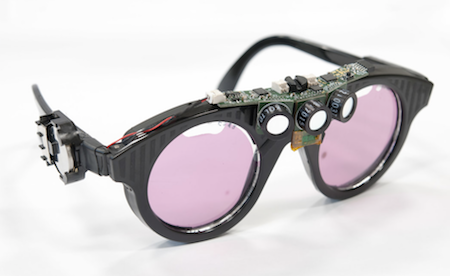
They began work on the “laser dazzle visor” in 2014 and hope to start selling to military, airline suppliers and emergency services in 2018.
From Folium Optics and the Express
US: Bird wearing tiny goggles safely flies through laser beam
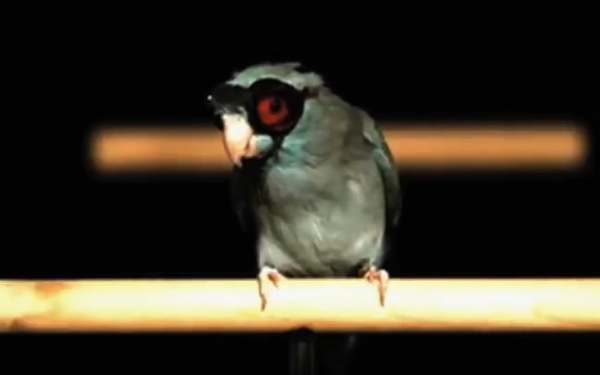
Researchers at Stanford University wanted to get data on how much lift a bird generates. To monitor the wing wake and vortices, they used a laser beam spread by a lens into a plane of light. The light source was a Litron brand double-pumped Neodymium-doped yttrium lithium fluoride (Nd:YLF) laser. The light was green at 527 nanometers, and had a pulse repetition rate of 1 kHz.
A non-toxic mist in the air illuminated the light sheet, just like theatrical fog used at concert laser light shows. As the bird flew through the light, the mist scattered and showed the air patterns, in a technique called “particle imaging velocimetry” or PIV.
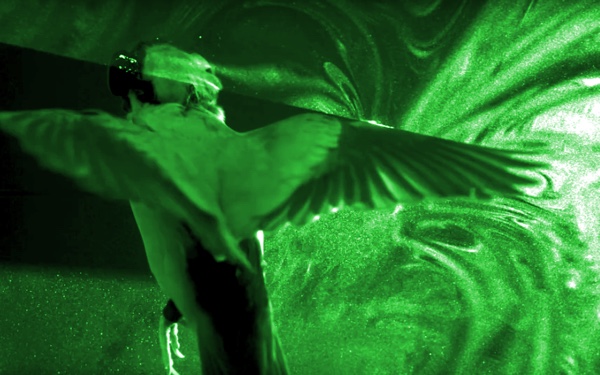
Bird-sized goggles were used to prevent any harm to the bird’s eyesight. The lenses came from human laser safety glasses and had an optical density of 6, meaning that they transmitted only 0.0001% of the laser light. The frame was 3D printed and was held on by veterinary tape. The goggles weighed 1.68 grams, which is roughly 6% of the bird’s body weight (equivalent to 9 pound glasses on a 150 lb. human).
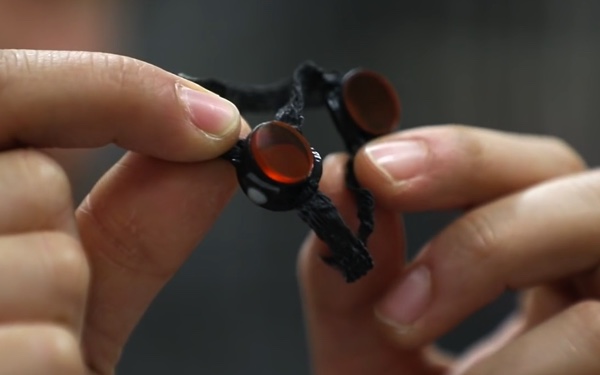
Before beginning the series of experiments, the researchers trained four parrotlets “through many small stress-free steps of habituation.” After “several months of effort” with the birds, only one — a parrotlet named “Obi” — voluntarily flew with the laser goggles. According to the researchers, “[a]ll training and experimental procedures were approved by Stanford's Administrative Panel on Laboratory Animal Care.”
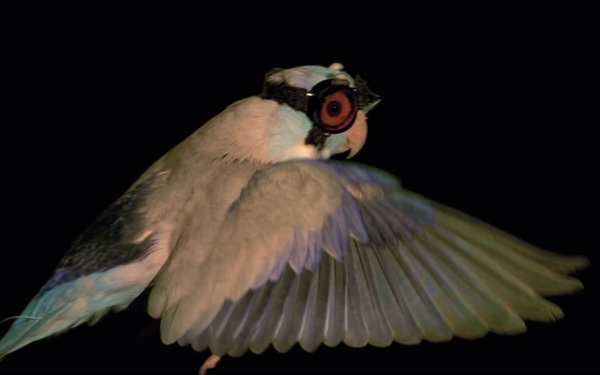
Twelve cameras were used. Four high-speed stereo cameras were for PIV particle motion recording and recorded 4000 frames per flight. Eight cameras were for recording Obi’s wing and head kinematics as it flew from one perch, through the laser light plane, to a landing perch.
The results give “the clearest picture to date of the wake left by a flying animal.” Unexpectedly, the wing tip vortices did not stay stable as happens with aircraft, but instead broke up quickly and violently. This had not been predicted by any previous models.
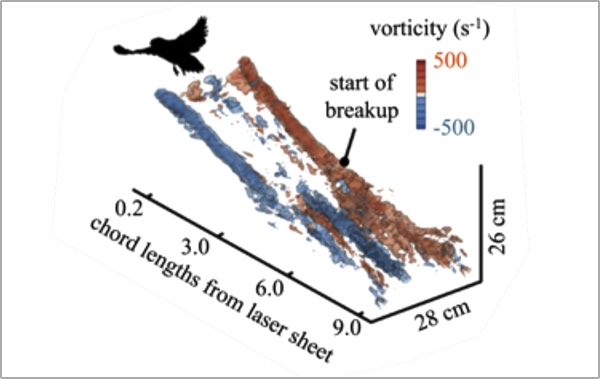
From a Stanford University news story, picked up by numerous websites and news outlets including Popular Mechanics, NBC News, The Verge, Optics.org and many others. The results were published December 6 2016 in the journal Bioinspiration & Biometrics, volume 12, number 1. Thanks to Drs. Ronald K.A.M. Mallant, MSc. for pointing out an error in our description of OD 6 density; the error has been corrected.
Japan: "Smartglasses" aim laser light directly into eyes
The laser is full color (red, green and blue combined) and is said to be harmless. The system was developed primarily as a vision aid for persons with visual defects. According to the news story, the image does not require focusing and is projected through the eye’s lens directly onto the retina.
The story notes that “the basic idea of projecting imagery onto a retina via laser has been around for decades, but miniaturizing the optics to realize a wearable form factor had been difficult until recently.”
A Fujitsu spinoff called QD Laser helped develop the glasses. They expect to begin selling them in March 2016 in Japan, Europe and the U.S. for about USD $2,000.
From PC World
US: Air Force study to help protect pilots from laser injuries
TASC is working on countermeasures such as laser eye protection and the development of procedures for injury assessment. The work is being performed under the Optical Radiation Bioeffects and Safety contract with the Air Force’s 711th Human Performance Wing’s Optical Radiation Bioeffects Branch at Fort Sam Houston in San Antonio, Texas.
From the San Antonio Business Journal
US: Army Research Laboratory works on laser protection for eyes, sensors, etc.
Laser protection team leader Andy Mott was quoted as saying “Lasers of varying pulse width and wavelength are being developed every day. We protect against the known threats, and unknown ones. We develop protection for electronic sensors of the future, as well as the sighting systems of today.”
More details are at the Military.com story
Canada: Iridian announces new anti-laser protection glasses
The LaseReflect Aviator LRG10 glasses are said to mitigate the effects of laser illumination incidents. They reflect more than 99% of 532 nanometer green laser light, the most common color in laser attacks. (According to FAA statistics, about 95% of reported incidents in recent years have involved green light.) They also reflect near-infrared light at 1064 nm, which often is a byproduct of green lasers that are not manufactured with adequate IR-blocking filters. The cost is USD $299.
Custom LaseReflect Aviator glasses are available for specific colors and powers, including multiple wavelengths in a single pair of glasses. For example, blue (405 nm and 445 nm) and red (650 nm) light can also be reflected by the glasses.
Click to read more...
US: Gold-coated nanotech could "laser-proof" pilots' glasses
According to a professor at Embry-Riddle Aeronautical University, gold-tinted eyewear has been used by military pilots for laser protection but only works against certain wavelengths of laser light. However, said Dan Macchiarella, if Thomas’ idea “could be applied to lasers of all strengths and wavelengths, that would certainly be a big advancement.”
A March 10 2013 Orlando Sentinel story noted that funding cuts and competition for grants mean that Thomas’ research faces “some serious hurdles” to develop this idea further. Thomas said finding research money is “going to be very difficult, very difficult.”
From the Orlando Sentinel
Israel: Advanced anti-laser filter announced
It is not clear whether the filter is available at this time (May 2012). The company intends to incorporate it into glasses and night-vision goggles worn by pilots, to protect against flash blindness, meaning power densities from 100 µW/cm² up to 1000 µW/cm².
From Optics.org
US: Air Force spending $2,400 each, for 3,000+ laser protection glasses
[NOTE: The amounts above represent about $2,400 per pair of laser protection spectacles. More information about anti-laser glasses for pilots, including non-military versions protecting against one or two visible wavelengths for roughly $100-200, is here.]
From a Teledyne Technologies press release
US: St. Louis area sheriff's department to use anti-laser glasses
The eyewear, made by NoiR, significantly reduces laser light, without adversely affecting pilot vision of cockpit instruments or airport lights. Because some laser light is transmitted, pilots and flight officers will still be able to track the source of a laser illumination.
The decision to purchase the glasses was made because of recent laser incidents in the St. Louis area. A spokesperson said the eyewear is “another tool to keep us in the air.”
From STLtoday.com